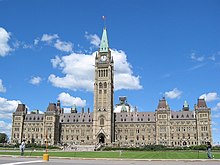Bank Act
| Bank Act | |
|---|---|
 |
|
| An Act respecting banks and banking | |
| Citation | Bank Act |
| Enacted by | Parliament of Canada |
| Date assented to | December 13, 1991 |
The Bank Act (1991, c. 46) is an Act of the Government of Canada respecting banks and banking.
The Bank Act was originally passed in 1871. The terms of the Act provide for a statutory review of the Act on a regular basis to ensure that legislators update the Act in order that it keep pace with developments in the financial system. Historically this was done on a decennial basis. In 1992 this requirement was changed to every five years. The Act contains a "sunset" clause providing that it and the bank charters provided by it will expire unless the statutory review is conducted every five years. The most recent statutory review of the Act took place in 2012.
On June 30, 2017, Office of the Superintendent of Financial Institutions issued an advisory stating that it planned to enforce the Bank Act's prohibition of the use of the word or verbiage "bank" in connection to any financial service that is not a bank, such as credit unions. They must remove all uses of the word "bank" or its derivatives from their websites by the end of 2017, from print materials by the end of June 2018, and from physical signage by the end of June 2019.
In 2010, parliament passed amendments to the Act to allow federal credit unions to exist as a new class of financial institution. Credit unions differ from banks in that they are member-owned, democratically controlled and governed by co-operative principles. The Bank Act allows that federal credit unions may either be created by five persons (of which three must be individuals), or through the continuance of one or more credit unions existing within provincial jurisdiction. The provisions came into force at the end of 2012.
The first federal credit union in Canada was UNI Financial Cooperation (formerly Mouvement des caisses populaires acadiennes), based in New Brunswick, which converted to a federal charter in 2016.
The Act groups banks in three schedules. Schedule I banks are domestic banks allowed to accept deposits. Schedule II banks are subsidiaries of foreign banks that allowed to accept deposits through branches in Canada. Schedule III banks are foreign banks with certain restrictions upon the banking business they can conduct in Canada.
The Canadian banking industry includes 20 domestic banks, 24 foreign bank subsidiaries and 22 foreign bank branches operating in Canada. The provincial-government-owned Alberta Treasury Branches and Canada's many credit unions are not included in this list.
...
Wikipedia
